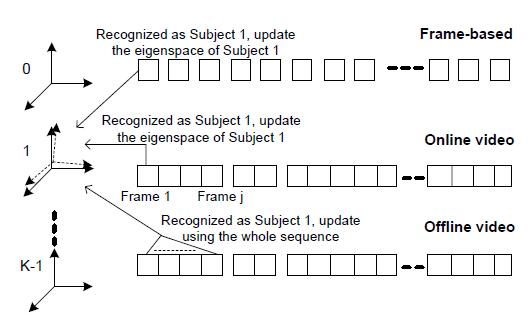contributions on Video-Based Face Recognition Using Adaptive Hidden Markov Models: Difference between revisions
(Created page with "==Video-based recognition== Here we try to look at two application scenarios investigated by the authors of the current paper. One is to recognize the human face from the video s...") |
|||
| Line 2: | Line 2: | ||
Here we try to look at two application scenarios investigated by the authors of the current paper. One is to recognize the human face from the video sequence in an online fashion and do not know when the subject will leave or another subject will come in. In this case, we need to know the recognition results up to the current frame immediately. Many online recognition and verification systems of human faces belong to this kind of application, which is called online video. The other scenario is to process the video content offline, like indexing the meeting records or analyzing surveillance videos, where what matters are the recognition results after all the frames of one sequence have been captured. Such scenario is called offline video. Both scenarios are illustrated in Figure 1. | Here we try to look at two application scenarios investigated by the authors of the current paper. One is to recognize the human face from the video sequence in an online fashion and do not know when the subject will leave or another subject will come in. In this case, we need to know the recognition results up to the current frame immediately. Many online recognition and verification systems of human faces belong to this kind of application, which is called online video. The other scenario is to process the video content offline, like indexing the meeting records or analyzing surveillance videos, where what matters are the recognition results after all the frames of one sequence have been captured. Such scenario is called offline video. Both scenarios are illustrated in Figure 1. | ||
[[File:1st_fig.JPG | [[File:1st_fig.JPG|Fig.1 Three application scenarios.]] | ||
Revision as of 02:42, 8 November 2011
Video-based recognition
Here we try to look at two application scenarios investigated by the authors of the current paper. One is to recognize the human face from the video sequence in an online fashion and do not know when the subject will leave or another subject will come in. In this case, we need to know the recognition results up to the current frame immediately. Many online recognition and verification systems of human faces belong to this kind of application, which is called online video. The other scenario is to process the video content offline, like indexing the meeting records or analyzing surveillance videos, where what matters are the recognition results after all the frames of one sequence have been captured. Such scenario is called offline video. Both scenarios are illustrated in Figure 1.
